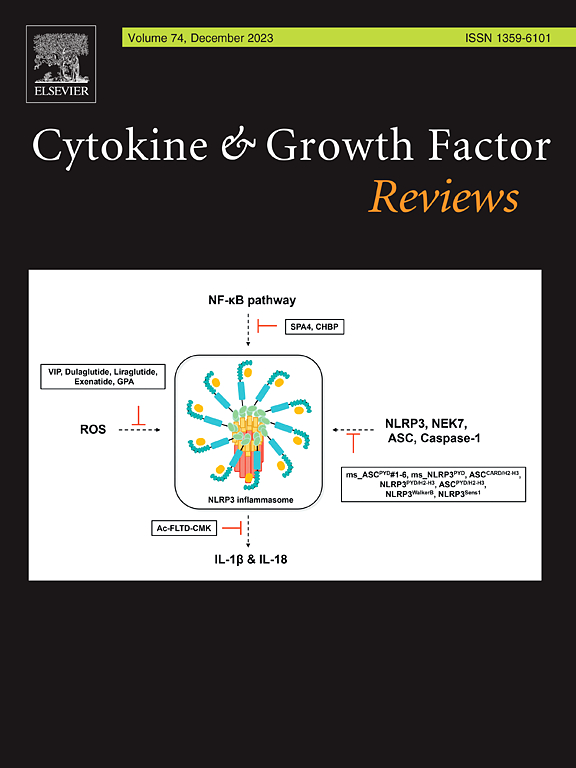基于tlr的肝细胞癌治疗策略。
IF 11.8
2区 医学
Q1 BIOCHEMISTRY & MOLECULAR BIOLOGY
引用次数: 0
摘要
肝细胞癌(HCC)是最常见的原发性肝癌,也是全球癌症相关死亡的主要原因。慢性炎症和免疫失调,通常由病毒感染或代谢紊乱驱动,在其发病机制中起重要作用。toll样受体(TLRs)是先天免疫的关键组成部分,在肝脏疾病和肿瘤发生的进展中已成为重要的调节因子。本综述旨在评估TLR信号在HCC的发生、进展和治疗潜力中的作用。虽然tlr主要存在于免疫细胞上,但它们在包括HCC在内的各种人类癌症中也有功能性表达。tlr,如TLR4,可以促进或抑制肿瘤进展,这取决于细胞背景和微环境。TLR多态性,包括TLR1 rs5743551和TLR4 rs1927914,与炎症、感染风险和癌症复发有关。尽管临床前研究支持使用TLR激动剂来增强免疫治疗,但由于患者反应不一致,其临床转化仍然有限。这可能是由于这些激动剂在肿瘤微环境中对不同类型的细胞发挥不同的作用。未来的研究应侧重于患者特异性TLR谱,开发改进的生物标志物,以及联合治疗以优化结果。了解tlr的双重作用可能会导致更精确和有效的HCC治疗。本文章由计算机程序翻译,如有差异,请以英文原文为准。
TLR-based therapeutic strategies for hepatocellular carcinoma
Hepatocellular carcinoma (HCC) is the most common primary liver cancer and a leading cause of cancer-related deaths worldwide. Chronic inflammation and immune dysregulation, often driven by viral infections or metabolic disorders, play a significant role in its pathogenesis. Toll-like receptors (TLRs), key components of innate immunity, have emerged as important regulators in the progression of liver disease and tumorigenesis. This review aims to evaluate the role of TLR signaling in the development, progression, and therapeutic potential of HCC. While TLRs are mainly found on immune cells, they are also functionally expressed in various human cancers, including HCC. TLRs, such as TLR4, can either promote or inhibit tumor progression, depending on the cellular context and microenvironment. TLR polymorphisms, including TLR1 rs5743551 and TLR4 rs1927914, are associated with inflammation, infection risk, and cancer recurrence. Although preclinical studies support the use of TLR agonists to enhance immunotherapy, their clinical translation remains limited due to inconsistent patient responses. This might be due to the diverse effects these agonists exert on various cell types within the tumor microenvironment. Future research should focus on patient-specific TLR profiles, the development of improved biomarkers, and the combination of therapies to optimize outcomes. Understanding the dual role of TLRs could lead to more precise and effective HCC treatments.
求助全文
通过发布文献求助,成功后即可免费获取论文全文。
去求助
来源期刊

Cytokine & Growth Factor Reviews
生物-生化与分子生物学
CiteScore
21.10
自引率
1.50%
发文量
61
审稿时长
22 days
期刊介绍:
Cytokine & Growth Factor Reviews is a leading publication that focuses on the dynamic fields of growth factor and cytokine research. Our journal offers a platform for authors to disseminate thought-provoking articles such as critical reviews, state-of-the-art reviews, letters to the editor, and meeting reviews.
We aim to cover important breakthroughs in these rapidly evolving areas, providing valuable insights into the multidisciplinary significance of cytokines and growth factors. Our journal spans various domains including signal transduction, cell growth and differentiation, embryonic development, immunology, tumorigenesis, and clinical medicine.
By publishing cutting-edge research and analysis, we aim to influence the way researchers and experts perceive and understand growth factors and cytokines. We encourage novel expressions of ideas and innovative approaches to organizing content, fostering a stimulating environment for knowledge exchange and scientific advancement.
 求助内容:
求助内容: 应助结果提醒方式:
应助结果提醒方式:


